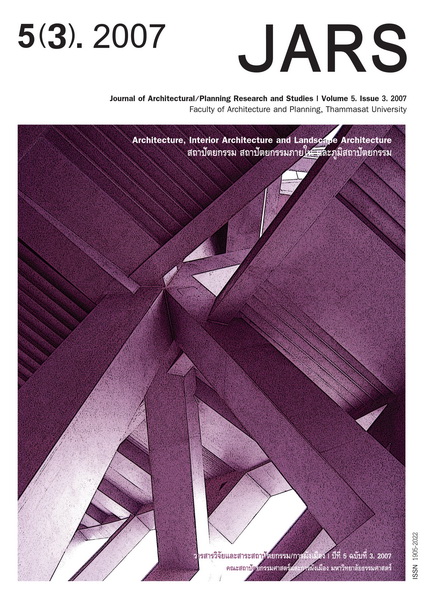The Practice of Critical Theory in Architectural Schools: Twenty First Century Transformation
Main Article Content
Abstract
Critical theory is an interdisciplinary way of thinking that tries to bridge the gap between architectural
theory and practice. During the past thirty years, the gap between the academic world of studio studies and
the academic world of history and theory studies has become increasingly difficult to bridge [1]. In other
words, the space of inquiry between architectural production and advanced scholarship has increased [2].
The task of architectural institutions today is thus to bring architectural education back to the interdisciplinary
equilibrium it was once familiar with. This paper reviews the frameworks of critical theory, which during the
past ten years has begun to replace the conventional history/theory approach in North American and
European schools as a vehicle to re-unite architectural theory and practice. The review focuses on a
selection of different modes that critical theory is taught and practiced, as well as ideas and principles of
critical theory that have become increasingly relevant in the discourse of architecture today. Priorities and
preoccupations of critical theory may help unfold the inherent complexity and contradiction within the
process of architectural creation. In architectural discourse, both theory and practice are reread repeatedly,
reworked and represented in roles that are well outside the original. Critical theory thus represents both
the pragmatic doctrine and the philosophical inquiry that partake in the potential of architectural design to
draw from the past and the present towards the future.
Downloads
Article Details

This work is licensed under a Creative Commons Attribution-NonCommercial-NoDerivatives 4.0 International License.
All material is licensed under the terms of the Creative Commons Attribution 4.0 International (CC-BY-NC-ND 4.0) License, unless otherwise stated. As such, authors are free to share, copy, and redistribute the material in any medium or format. The authors must give appropriate credit, provide a link to the license, and indicate if changes were made. The authors may do so in any reasonable manner, but not in any way that suggests the licensor endorses you or your use. The authors may not use the material for commercial purposes. If the authors remix, transform, or build upon the material, they may not distribute the modified material, unless permission is obtained from JARS. Final, accepted versions of the paper may be posted on third party repositories, provided appropriate acknowledgement to the original source is clearly noted.
References
Jarzombek, M. (1999). The disciplinary dislocations of architectural history. Journal of the Society of Architectural Historians, 58(3), 488-493.
Vickery, R. (1980). Teaching theory to beginning students. Journal of Architectural Education, 33(3), 19-20.
Rendell, J. (2007). Art and architecture: A place between. London: I. B. Tauris.
Schwarzer, M. (1995). German architectural theory and the search for modern identity. New York: Cambridge University Press.
Fiedler, K. (1994). Observation on the nature and history of architecture. In H. Malgrave (Ed.), Empathy, form, and space (pp. 125-148). Santa Monica, CA: The Getty Center.
Rykwert, J. (1983). The necessity of artifice. New York: Rizzoli.
Rendell, J. (2007). Art and architecture: A place between. London: I. B. Tauris.
Adams, H. (2004). Critical theory since Plato. London: Wadsworth Publishing.
Anderson, S. (1999). Architectural history in schools of architecture. The Journal of the Society of Architectural Historians, 58(3), 282-290.
Ballantyne, A. (2005). Architecture theory. New York: Continuum.
Borden, I. (2000). Architectural histories and critical theories. London: Routledge.
Bourdieu, P. (1977). Outline of a theory of practice. Cambridge: Cambridge University Press.
Bourdieu, P. (1992). The logic of practice. Stanford, CA: Stanford University Press.
Cacciari, M. (1993). Architecture and Nihilism: On the philosophy of modern architecture. New Haven: Yale University Press.
Dal Co, F. (1990). Figures of architecture and thought. New York: Rizzoli.
Fiedler, K. (1994). Observation on the nature and history of architecture. Empathy, Form, and Space, 125-148.
Forty, A. (2004). Words and building: A vocabulary of modern architecture. London: Thames and Hudson.
Frampton, K. (2004). The evolution of 20th century architecture: A synoptic account. New York: Springer.
Hays, M. (2000). Architecture theory since 1968. Cambridge, MA: MIT Press.
Hays, M. (1998). Oppositions reader: Selected essays 1973-1984. New York: Princeton Architectural Press.
Held, D. (1980). Introduction to critical theory: Horkheimer to Habermas. Los Angeles, CA: University of California Press.
Horkheimer, M. (1975). Critical theory. London: Continuum.
Ingram, D. (1992). Critical theory: The essential readings. New York: Paragon House.
Jarzombeck, M. (1999). The disciplinary dislocations of architectural history. The Journal of the Society of Architectural Historians, 53(3), 488-493.
Jencks, C. (Ed.). (2006). Theories and manifestoes of contemporary architecture. London: Academy Press.
Kwinter, S. (2008). Far from equilibrium: Essays on technology and design culture. New York: Actar.
Leach, N. (Ed.). (1997). Rethinking architecture: Reader in cultural theory. London: Routledge.
Leatherbarrow, D. (2000). Uncommon ground: Architecture, technology, and topography. Cambridge, MA: MIT Press.
Mallgrave, H. F. (Ed.). (2005). Architecture theory: An anthology from vitruvius to 1870. New York: WlieyBlackwell.
Mallgrave, H. F. (Ed.). (2008). Architecture theory: An anthology from 1871 to 2005. New York: Wliey-Blackwell.
Ockman, J. (1993). Architecture culture 1943-1968: A documentary anthology. New York: Rizzoli.
Rendell, J. (2007). Art and architecture: A place between. London: I. B. Tauris.
Rendell, J. (Ed.). (2007). Critical architecture. London: Routledge.
Rykwert, J. (1983). The necessity of artifice. New York: Rizzoli.
Tafuri, M. (1980). Theories and history of architecture. New York: Harper & Row.
Vickery, R. (1980). Teaching theory to beginning students. The Journal of Architectural Education, 33(3), 19-20.
Vidler, A. (2008). Histories of the immediate present: Inventing architectural modernism. Cambridge, MA: MIT Press.
Vidler, A. (2008). Architecture between spectacle and use. New York: Clark Art Institute.


